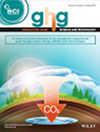求助PDF
{"title":"地质储碳管理中CO2泄漏风险定量评价","authors":"Meng Jing, Qi Li, Guizhen Liu, Quan Xue","doi":"10.1002/ghg.2315","DOIUrl":null,"url":null,"abstract":"<p>Large-scale geological storage of carbon dioxide (CO<sub>2</sub>) is indispensable for mitigating climate change but faces significant challenges, especially in the accurate quantitative assessment of leakage risks to ensure long-term security. Given these circumstances, this paper proposes an innovative approach for quantitatively assessing CO<sub>2</sub> leakage risk to address the previous limitations of limited accuracy and insufficient data. We construct a fault tree and transform it into a Bayesian network–directed acyclic graph, and then use judgment sets along with fuzzy set theory to obtain prior probabilities of root nodes. The feature, event, and process method was utilized to identify key components and subsequently determine the conditional probability table (CPT) of the leaf node. The subjective experience assessments from experts are defuzzified to obtain the CPTs of intermediate nodes. The obtained basic probability parameters are input into the directed acyclic graph to complete the model construction. After calculating the leakage probability using this model, it is combined with the severity of impacts to conduct a comprehensive risk assessment. Furthermore, critical CO<sub>2</sub> risk sources can be determined through posterior probability calculations when intermediate nodes are designated as deterministic risk events. The gradual implementation process of the proposed model is demonstrated via a typical case study. The results indicate an overall CO<sub>2</sub> leakage probability of 29%, with probabilities of leakage along faults/fractures, caprock, and well identified as 32%, 28%, and 19%, respectively. The project is categorized as a medium-low risk level. When leakage is confirmed, tectonic movement, thickness, and delamination at interface connections/the presence of cracks are the critical risk sources, and measures to mitigate key risks are outlined. The identified key risk factors conform to empirical evidence and previous research, validating the accuracy of the model. This study is instrumental in CO<sub>2</sub> geological storage risk assessment and scalable development program design. © 2024 Society of Chemical Industry and John Wiley & Sons, Ltd.</p>","PeriodicalId":12796,"journal":{"name":"Greenhouse Gases: Science and Technology","volume":"14 6","pages":"1068-1091"},"PeriodicalIF":2.7000,"publicationDate":"2024-11-12","publicationTypes":"Journal Article","fieldsOfStudy":null,"isOpenAccess":false,"openAccessPdf":"","citationCount":"0","resultStr":"{\"title\":\"Quantitative assessment of CO2 leakage risk in geologic carbon storage management\",\"authors\":\"Meng Jing, Qi Li, Guizhen Liu, Quan Xue\",\"doi\":\"10.1002/ghg.2315\",\"DOIUrl\":null,\"url\":null,\"abstract\":\"<p>Large-scale geological storage of carbon dioxide (CO<sub>2</sub>) is indispensable for mitigating climate change but faces significant challenges, especially in the accurate quantitative assessment of leakage risks to ensure long-term security. Given these circumstances, this paper proposes an innovative approach for quantitatively assessing CO<sub>2</sub> leakage risk to address the previous limitations of limited accuracy and insufficient data. We construct a fault tree and transform it into a Bayesian network–directed acyclic graph, and then use judgment sets along with fuzzy set theory to obtain prior probabilities of root nodes. The feature, event, and process method was utilized to identify key components and subsequently determine the conditional probability table (CPT) of the leaf node. The subjective experience assessments from experts are defuzzified to obtain the CPTs of intermediate nodes. The obtained basic probability parameters are input into the directed acyclic graph to complete the model construction. After calculating the leakage probability using this model, it is combined with the severity of impacts to conduct a comprehensive risk assessment. Furthermore, critical CO<sub>2</sub> risk sources can be determined through posterior probability calculations when intermediate nodes are designated as deterministic risk events. The gradual implementation process of the proposed model is demonstrated via a typical case study. The results indicate an overall CO<sub>2</sub> leakage probability of 29%, with probabilities of leakage along faults/fractures, caprock, and well identified as 32%, 28%, and 19%, respectively. The project is categorized as a medium-low risk level. When leakage is confirmed, tectonic movement, thickness, and delamination at interface connections/the presence of cracks are the critical risk sources, and measures to mitigate key risks are outlined. The identified key risk factors conform to empirical evidence and previous research, validating the accuracy of the model. This study is instrumental in CO<sub>2</sub> geological storage risk assessment and scalable development program design. © 2024 Society of Chemical Industry and John Wiley & Sons, Ltd.</p>\",\"PeriodicalId\":12796,\"journal\":{\"name\":\"Greenhouse Gases: Science and Technology\",\"volume\":\"14 6\",\"pages\":\"1068-1091\"},\"PeriodicalIF\":2.7000,\"publicationDate\":\"2024-11-12\",\"publicationTypes\":\"Journal Article\",\"fieldsOfStudy\":null,\"isOpenAccess\":false,\"openAccessPdf\":\"\",\"citationCount\":\"0\",\"resultStr\":null,\"platform\":\"Semanticscholar\",\"paperid\":null,\"PeriodicalName\":\"Greenhouse Gases: Science and Technology\",\"FirstCategoryId\":\"93\",\"ListUrlMain\":\"https://onlinelibrary.wiley.com/doi/10.1002/ghg.2315\",\"RegionNum\":4,\"RegionCategory\":\"环境科学与生态学\",\"ArticlePicture\":[],\"TitleCN\":null,\"AbstractTextCN\":null,\"PMCID\":null,\"EPubDate\":\"\",\"PubModel\":\"\",\"JCR\":\"Q3\",\"JCRName\":\"ENERGY & FUELS\",\"Score\":null,\"Total\":0}","platform":"Semanticscholar","paperid":null,"PeriodicalName":"Greenhouse Gases: Science and Technology","FirstCategoryId":"93","ListUrlMain":"https://onlinelibrary.wiley.com/doi/10.1002/ghg.2315","RegionNum":4,"RegionCategory":"环境科学与生态学","ArticlePicture":[],"TitleCN":null,"AbstractTextCN":null,"PMCID":null,"EPubDate":"","PubModel":"","JCR":"Q3","JCRName":"ENERGY & FUELS","Score":null,"Total":0}
引用次数: 0
引用
批量引用

 求助内容:
求助内容: 应助结果提醒方式:
应助结果提醒方式:


